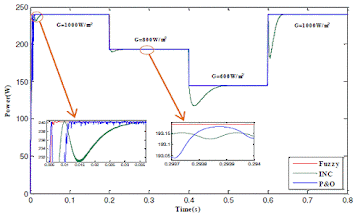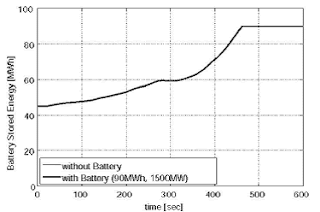ABSTRACT:
This paper proposes a grid interactive bidirectional
solar water pumping system using a three phase induction motor drive (IMD). A
single phase voltage source converter (VSC) is used to direct the flow of power
from grid supply to the pump and back to the grid from SPV array. A boost
converter is used for the maximum power point tracking (MPPT) of the SPV array.
A smart power sharing control is proposed, with preference given to the power
from SPV array over the grid power. Moreover, the grid input power quality is
also improved. Various modes of operation of the pump are elaborated and the performance
of the system at starting, in steady state and dynamic conditions are
simulated. The simulated results show the novelty and the satisfactory
performance of the system.
KEYWORDS:
1.
Solar water pump
2.
MPPT
3.
Grid interactive
4.
Smart power sharing
SOFTWARE: MATLAB/SIMULINK
Fig. 1. Configuration for the single phase grid interactive SPV water pumping system
Fig. 2(a) Starting performance of the proposed system in mode I
Fig. 2(b) Steady state performance of the proposed system in mode I
Fig. 2(c) Performance of the system in mode I under decreasing radiation from 800 W/m2 to 500 W/m2
Fig. 3(a) Starting performance of the system in mode II
Fig. 3(b) Steady state performance of the system in mode II
Fig. 4(a) Characteristics of the system in mode III with decrease in Radiation
Fig. 4(b) Characteristics of the system in mode III with increase in Radiation
Fig. 5(a) Characteristics of the system in mode IV with increase in Radiation
CONCLUSION:
A
single phase grid interactive solar water pumping is presented in the paper.
Various modes of operation are identified and simulated in MATLAB Simulink
environment. The simulated results have demonstrated the satisfactory performance
of the system at starting, and in steady and dynamic conditions. The proposed
system not only is able to share the power between two sources but it also
improves the quality of power drawn. Moreover, the system manages to feed the
power from the SPV array as in when required. The system is well suited for the
rural and agricultural usage.
REFERENCES:
[1]
J. Zhu, “Application of Renewable Energy,” in Optimization of Power System
Operation, Wiley-IEEE Press, 2015, p. 664.
[2]
Z. Ying, M. Liao, X. Yang, C. Han, J. Li, J. Li, Y. Li, P. Gao, and J. Ye, “High-Performance
Black Multicrystalline Silicon Solar Cells by a Highly Simplified
Metal-Catalyzed Chemical Etching Method,” IEEE J. Photovolt., vol. PP, no. 99,
pp. 1–06, 2016.
[3]
M. Steiner, G. Siefer, T. Schmidt, M. Wiesenfarth, F. Dimroth, and A. W. Bett, “43%
Sunlight to Electricity Conversion Efficiency Using CPV,” IEEE J. Photovolt.,
vol. PP, no. 99, pp. 1–5, 2016.
[4]
M. Kolhe, J. C. Joshi, and D. P. Kothari, “Performance analysis of a directly
coupled photovoltaic water-pumping system,” IEEE Trans. Energy Convers., vol.
19, no. 3, pp. 613–618, Sep. 2004.
[5]
S. R. Bhat, A. Pittet, and B. S. Sonde, “Performance Optimization of Induction
Motor-Pump System Using Photovoltaic Energy Source,” IEEE Trans. Ind. Appl.,
vol. IA-23, no. 6, pp. 995–1000, Nov. 1987.



































